MGT230 - Facility Management: Risk Assessment in Hospitality
VerifiedAdded on 2022/10/12
|12
|2965
|207
Report
AI Summary
This report, focusing on facility management within the hospitality industry, explores the critical aspects of risk management. It begins by emphasizing the significance of risk management in providing a safe work environment for employees, particularly within hotels and restaurants. The research question addresses potential hazards in event management and mitigation strategies. The report details the steps of implementing a risk management plan, including establishing context, identifying hazards through desktop and on-site information collection, and conducting risk assessments to understand the effectiveness of existing controls. It examines various risk factors, such as physical, chemical, ergonomic, psychological, and mechanical hazards, and provides examples of high- and low-risk scenarios. Finally, the report discusses risk control strategies like elimination, isolation, substitution, engineering, administrative, and personal protective measures. The importance of training and awareness is highlighted, along with the cost considerations in implementing these controls.
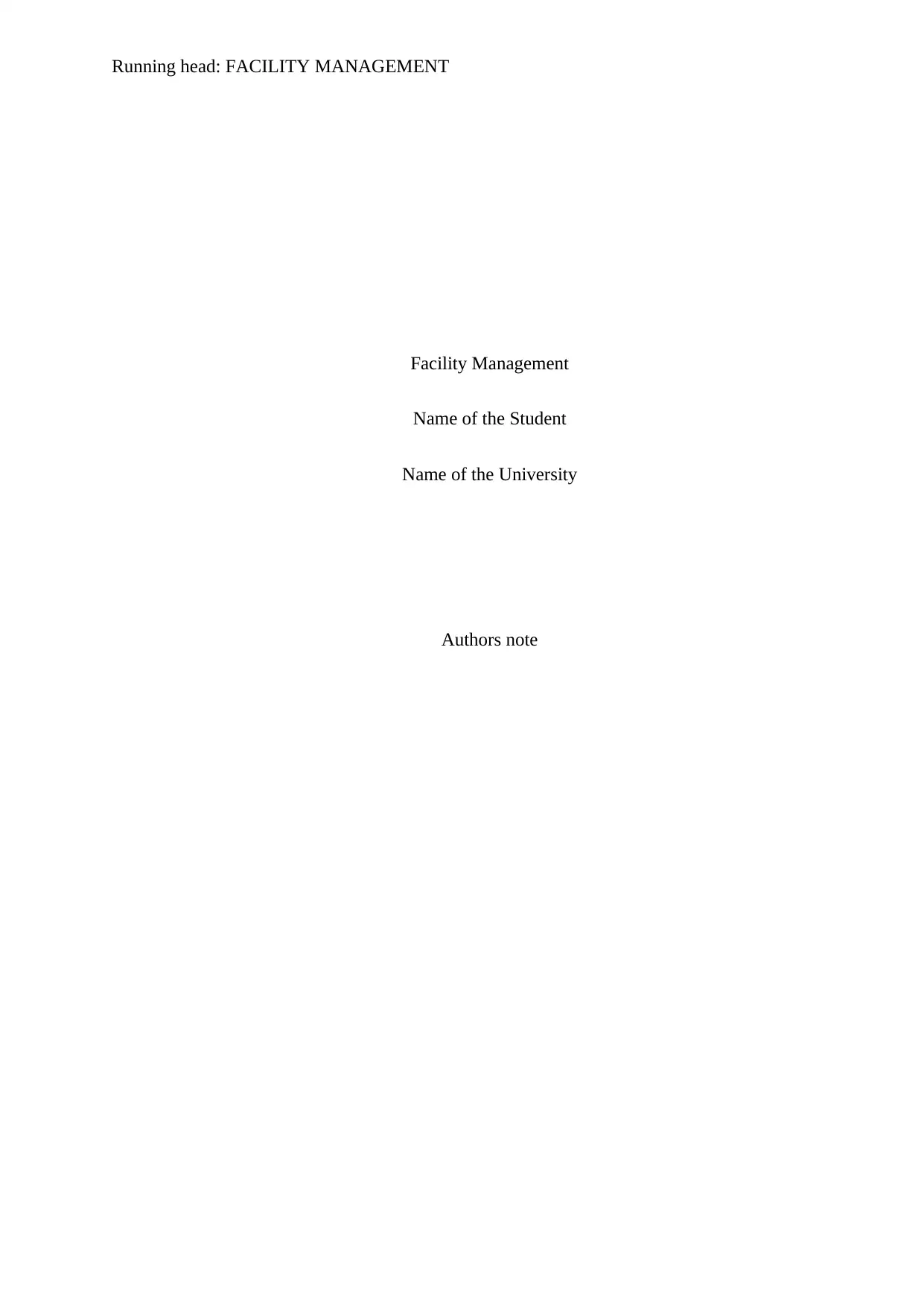
Running head: FACILITY MANAGEMENT
Facility Management
Name of the Student
Name of the University
Authors note
Facility Management
Name of the Student
Name of the University
Authors note
Paraphrase This Document
Need a fresh take? Get an instant paraphrase of this document with our AI Paraphraser

1
FACILITY MANAGEMENT
Executive Summary
This report talks about the risk management measures in the hospitality industry. Risk
management in an integral part now a days in every organisation. Risk management plans are
suggested to provide the facility of safe workplace environment to the workers. The
importance of risk management is assessed in the first part of the report. The parts and steps
of implementing the RM plan is discussed in the main part of this report. The focus is mainly
on the hotel and restaurant industry. What the researcher has learned from this report is also
described. The report ends with a concluding paragraph at the end.
FACILITY MANAGEMENT
Executive Summary
This report talks about the risk management measures in the hospitality industry. Risk
management in an integral part now a days in every organisation. Risk management plans are
suggested to provide the facility of safe workplace environment to the workers. The
importance of risk management is assessed in the first part of the report. The parts and steps
of implementing the RM plan is discussed in the main part of this report. The focus is mainly
on the hotel and restaurant industry. What the researcher has learned from this report is also
described. The report ends with a concluding paragraph at the end.
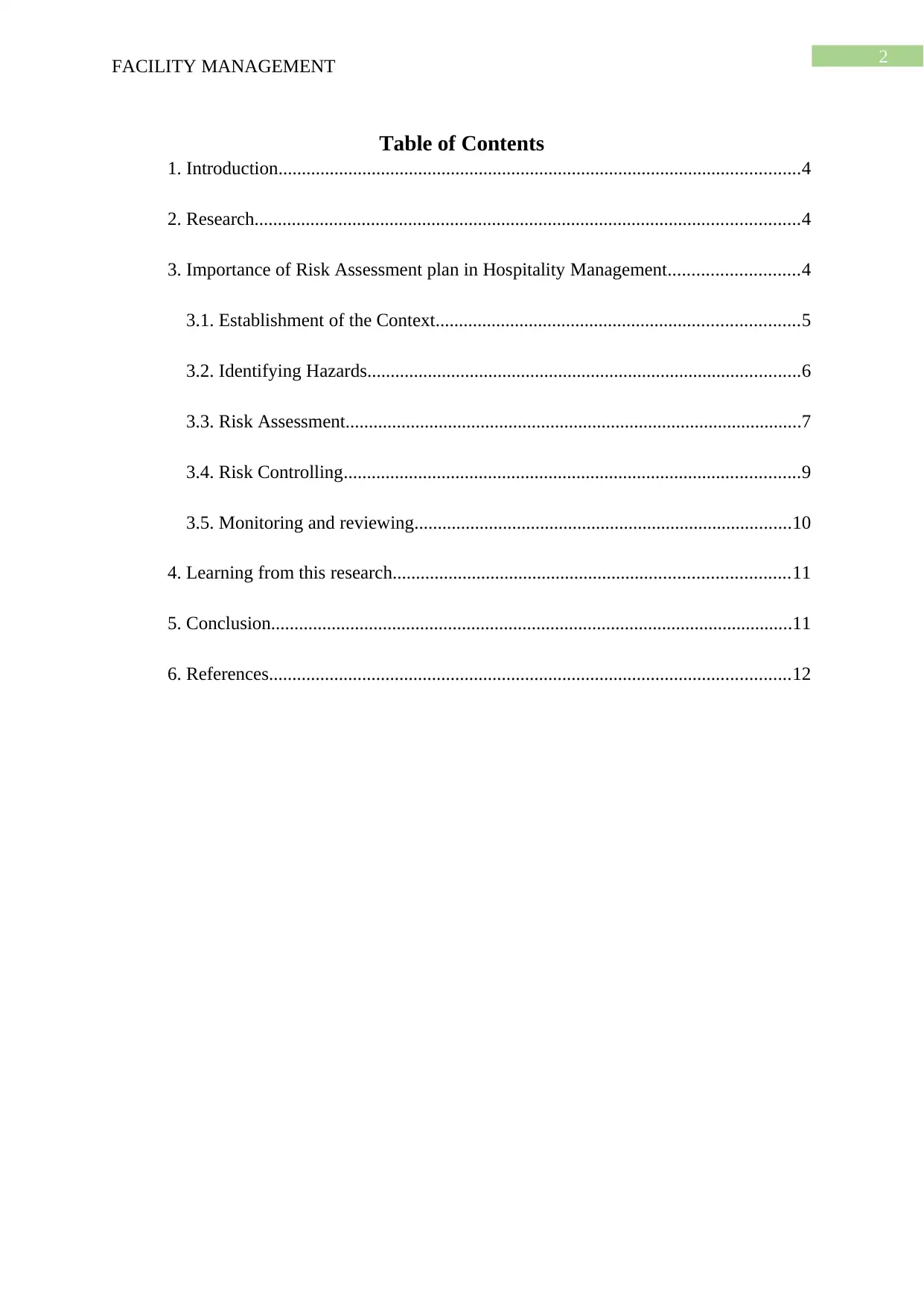
2
FACILITY MANAGEMENT
Table of Contents
1. Introduction................................................................................................................4
2. Research.....................................................................................................................4
3. Importance of Risk Assessment plan in Hospitality Management............................4
3.1. Establishment of the Context..............................................................................5
3.2. Identifying Hazards.............................................................................................6
3.3. Risk Assessment..................................................................................................7
3.4. Risk Controlling..................................................................................................9
3.5. Monitoring and reviewing.................................................................................10
4. Learning from this research.....................................................................................11
5. Conclusion................................................................................................................11
6. References................................................................................................................12
FACILITY MANAGEMENT
Table of Contents
1. Introduction................................................................................................................4
2. Research.....................................................................................................................4
3. Importance of Risk Assessment plan in Hospitality Management............................4
3.1. Establishment of the Context..............................................................................5
3.2. Identifying Hazards.............................................................................................6
3.3. Risk Assessment..................................................................................................7
3.4. Risk Controlling..................................................................................................9
3.5. Monitoring and reviewing.................................................................................10
4. Learning from this research.....................................................................................11
5. Conclusion................................................................................................................11
6. References................................................................................................................12
⊘ This is a preview!⊘
Do you want full access?
Subscribe today to unlock all pages.

Trusted by 1+ million students worldwide

3
FACILITY MANAGEMENT
1. Introduction
Managing the workplace risk is necessary for the organisation to provide their
employees with a safe and positive work environment. Facility management is the part of
industries that assures workers with important support systems. In order to achieve higher
organisational goals, the authority need to address the issues related to the well-being of their
employees. The idea of risk management have this aspects at its heart. Risk management is
the process of identifying, analysing, assessing and thereby, avoiding the possible risks.
Implementing a risk management plan in hospitality industry is a priority. The hospitality
providers have to face a set of risks in their daily works. There need to be the assessment of
the probable risk and plan for avoiding it in workplace. Examples of high and low physical
and psychological risks in this field is common. This report will talk about the kinds of risks
that the hospitality providers face in their day to day operations. Another subject of study will
be risk assessment plan and mitigation plan implementation.
2. Research Question
What are the potential risks in a big event management site and what plan could be
implemented to avoid such workplace hazards?
3. Importance of Risk Assessment plan in Hospitality Management
Hospitality industry has identified various risks associated with their work
environment. Event management is the part of this industry that involves the work having
high probability of workplace hazards. It is necessary for the organisations in the hospitality
industry to ensure the health and well-being of their employees. Injury that happens in the
work sites could not only affect the employees but this can enhance the production time and
cost (Oh, 2015). Companies now a days invest in their risk management plan so that they
FACILITY MANAGEMENT
1. Introduction
Managing the workplace risk is necessary for the organisation to provide their
employees with a safe and positive work environment. Facility management is the part of
industries that assures workers with important support systems. In order to achieve higher
organisational goals, the authority need to address the issues related to the well-being of their
employees. The idea of risk management have this aspects at its heart. Risk management is
the process of identifying, analysing, assessing and thereby, avoiding the possible risks.
Implementing a risk management plan in hospitality industry is a priority. The hospitality
providers have to face a set of risks in their daily works. There need to be the assessment of
the probable risk and plan for avoiding it in workplace. Examples of high and low physical
and psychological risks in this field is common. This report will talk about the kinds of risks
that the hospitality providers face in their day to day operations. Another subject of study will
be risk assessment plan and mitigation plan implementation.
2. Research Question
What are the potential risks in a big event management site and what plan could be
implemented to avoid such workplace hazards?
3. Importance of Risk Assessment plan in Hospitality Management
Hospitality industry has identified various risks associated with their work
environment. Event management is the part of this industry that involves the work having
high probability of workplace hazards. It is necessary for the organisations in the hospitality
industry to ensure the health and well-being of their employees. Injury that happens in the
work sites could not only affect the employees but this can enhance the production time and
cost (Oh, 2015). Companies now a days invest in their risk management plan so that they
Paraphrase This Document
Need a fresh take? Get an instant paraphrase of this document with our AI Paraphraser
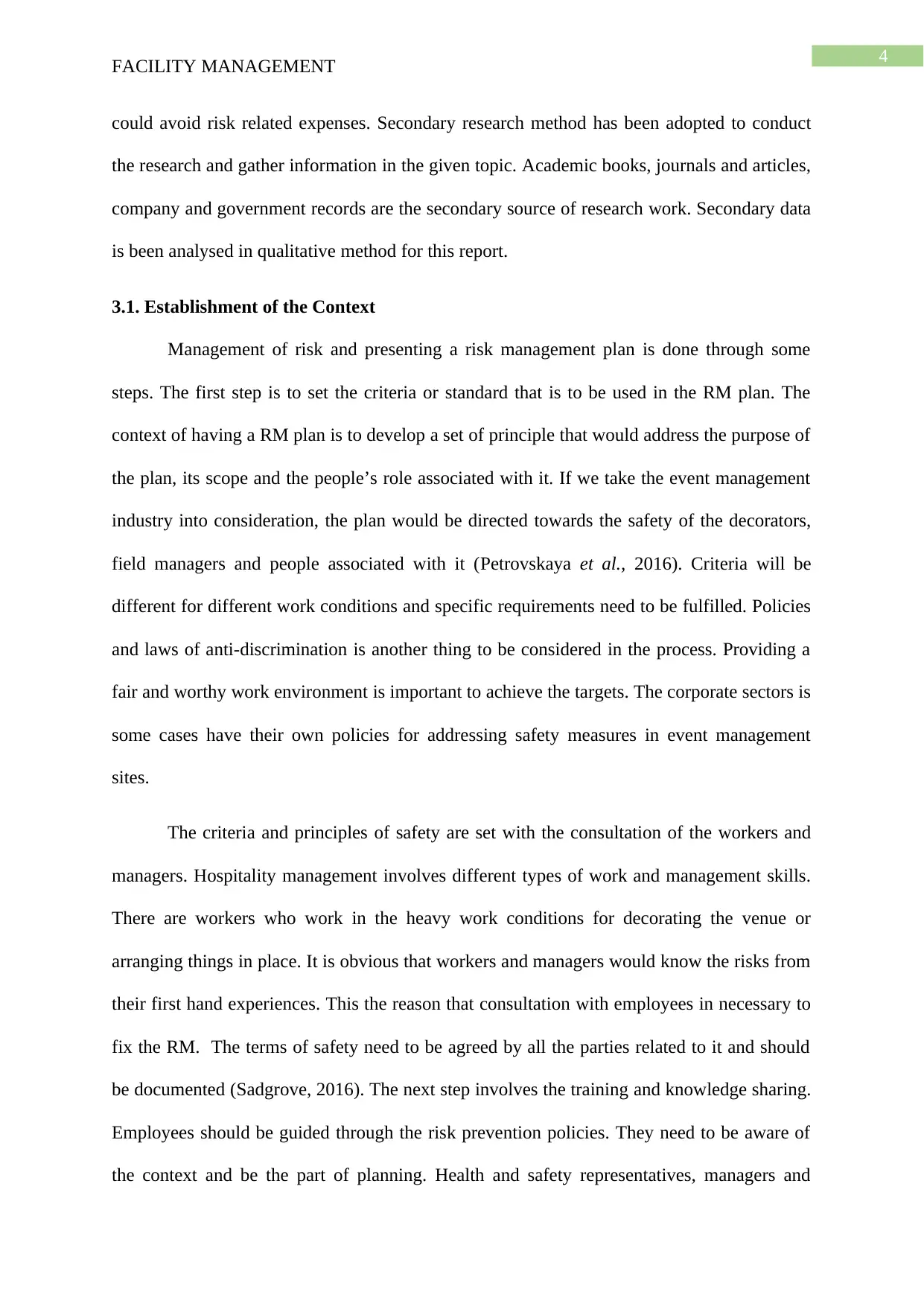
4
FACILITY MANAGEMENT
could avoid risk related expenses. Secondary research method has been adopted to conduct
the research and gather information in the given topic. Academic books, journals and articles,
company and government records are the secondary source of research work. Secondary data
is been analysed in qualitative method for this report.
3.1. Establishment of the Context
Management of risk and presenting a risk management plan is done through some
steps. The first step is to set the criteria or standard that is to be used in the RM plan. The
context of having a RM plan is to develop a set of principle that would address the purpose of
the plan, its scope and the people’s role associated with it. If we take the event management
industry into consideration, the plan would be directed towards the safety of the decorators,
field managers and people associated with it (Petrovskaya et al., 2016). Criteria will be
different for different work conditions and specific requirements need to be fulfilled. Policies
and laws of anti-discrimination is another thing to be considered in the process. Providing a
fair and worthy work environment is important to achieve the targets. The corporate sectors is
some cases have their own policies for addressing safety measures in event management
sites.
The criteria and principles of safety are set with the consultation of the workers and
managers. Hospitality management involves different types of work and management skills.
There are workers who work in the heavy work conditions for decorating the venue or
arranging things in place. It is obvious that workers and managers would know the risks from
their first hand experiences. This the reason that consultation with employees in necessary to
fix the RM. The terms of safety need to be agreed by all the parties related to it and should
be documented (Sadgrove, 2016). The next step involves the training and knowledge sharing.
Employees should be guided through the risk prevention policies. They need to be aware of
the context and be the part of planning. Health and safety representatives, managers and
FACILITY MANAGEMENT
could avoid risk related expenses. Secondary research method has been adopted to conduct
the research and gather information in the given topic. Academic books, journals and articles,
company and government records are the secondary source of research work. Secondary data
is been analysed in qualitative method for this report.
3.1. Establishment of the Context
Management of risk and presenting a risk management plan is done through some
steps. The first step is to set the criteria or standard that is to be used in the RM plan. The
context of having a RM plan is to develop a set of principle that would address the purpose of
the plan, its scope and the people’s role associated with it. If we take the event management
industry into consideration, the plan would be directed towards the safety of the decorators,
field managers and people associated with it (Petrovskaya et al., 2016). Criteria will be
different for different work conditions and specific requirements need to be fulfilled. Policies
and laws of anti-discrimination is another thing to be considered in the process. Providing a
fair and worthy work environment is important to achieve the targets. The corporate sectors is
some cases have their own policies for addressing safety measures in event management
sites.
The criteria and principles of safety are set with the consultation of the workers and
managers. Hospitality management involves different types of work and management skills.
There are workers who work in the heavy work conditions for decorating the venue or
arranging things in place. It is obvious that workers and managers would know the risks from
their first hand experiences. This the reason that consultation with employees in necessary to
fix the RM. The terms of safety need to be agreed by all the parties related to it and should
be documented (Sadgrove, 2016). The next step involves the training and knowledge sharing.
Employees should be guided through the risk prevention policies. They need to be aware of
the context and be the part of planning. Health and safety representatives, managers and

5
FACILITY MANAGEMENT
workers need to be trained of the RM plan and hazard register usage. The hazard register and
risk management instructions should be in easy and assessable format.
3.2. Identifying Hazards
Step two of implementing risk management plan is identifying the hazards. There is a
basic difference between hazards and risks. Hazards are the reason and risk is the possible
consequence of that hazard. Therefore, to assess the risk, identifying the hazards are
important. Role of the supervisors and workers is important is identifying the hazards. The
facility manager could ask the workers about the possible situations and their reasons that
could harm people psychologically and physically (Apostolou, 2019). Hazard group could be
created to evaluate the risks. For example, in the event management the hazards could be
grouped under chemical, physical, ergonomic, psychological and mechanical and electric.
Physical Working at height, moving vehicles, dust
Chemical Heavy metals, skin irritants in decoration products
Ergonomic Manual handling of heavy tools, poorly build stages
Psychological Work related stress, deadlines, racial or sexual harassments, violence
and bullying in work site
Mechanical Faulty machinery and tools
Table 1: Hazard Group for event management works
(Source: created by the author)
These criteria of hazard could be included in the hazard register. The identification of
hazard could be done in two ways, the first is Desktop collection. The information of the
hazards that are collected from company records are desktop information collection. This
may include, organisations incident statistics, job safety analysis or JBA, inspections,
FACILITY MANAGEMENT
workers need to be trained of the RM plan and hazard register usage. The hazard register and
risk management instructions should be in easy and assessable format.
3.2. Identifying Hazards
Step two of implementing risk management plan is identifying the hazards. There is a
basic difference between hazards and risks. Hazards are the reason and risk is the possible
consequence of that hazard. Therefore, to assess the risk, identifying the hazards are
important. Role of the supervisors and workers is important is identifying the hazards. The
facility manager could ask the workers about the possible situations and their reasons that
could harm people psychologically and physically (Apostolou, 2019). Hazard group could be
created to evaluate the risks. For example, in the event management the hazards could be
grouped under chemical, physical, ergonomic, psychological and mechanical and electric.
Physical Working at height, moving vehicles, dust
Chemical Heavy metals, skin irritants in decoration products
Ergonomic Manual handling of heavy tools, poorly build stages
Psychological Work related stress, deadlines, racial or sexual harassments, violence
and bullying in work site
Mechanical Faulty machinery and tools
Table 1: Hazard Group for event management works
(Source: created by the author)
These criteria of hazard could be included in the hazard register. The identification of
hazard could be done in two ways, the first is Desktop collection. The information of the
hazards that are collected from company records are desktop information collection. This
may include, organisations incident statistics, job safety analysis or JBA, inspections,
⊘ This is a preview!⊘
Do you want full access?
Subscribe today to unlock all pages.

Trusted by 1+ million students worldwide
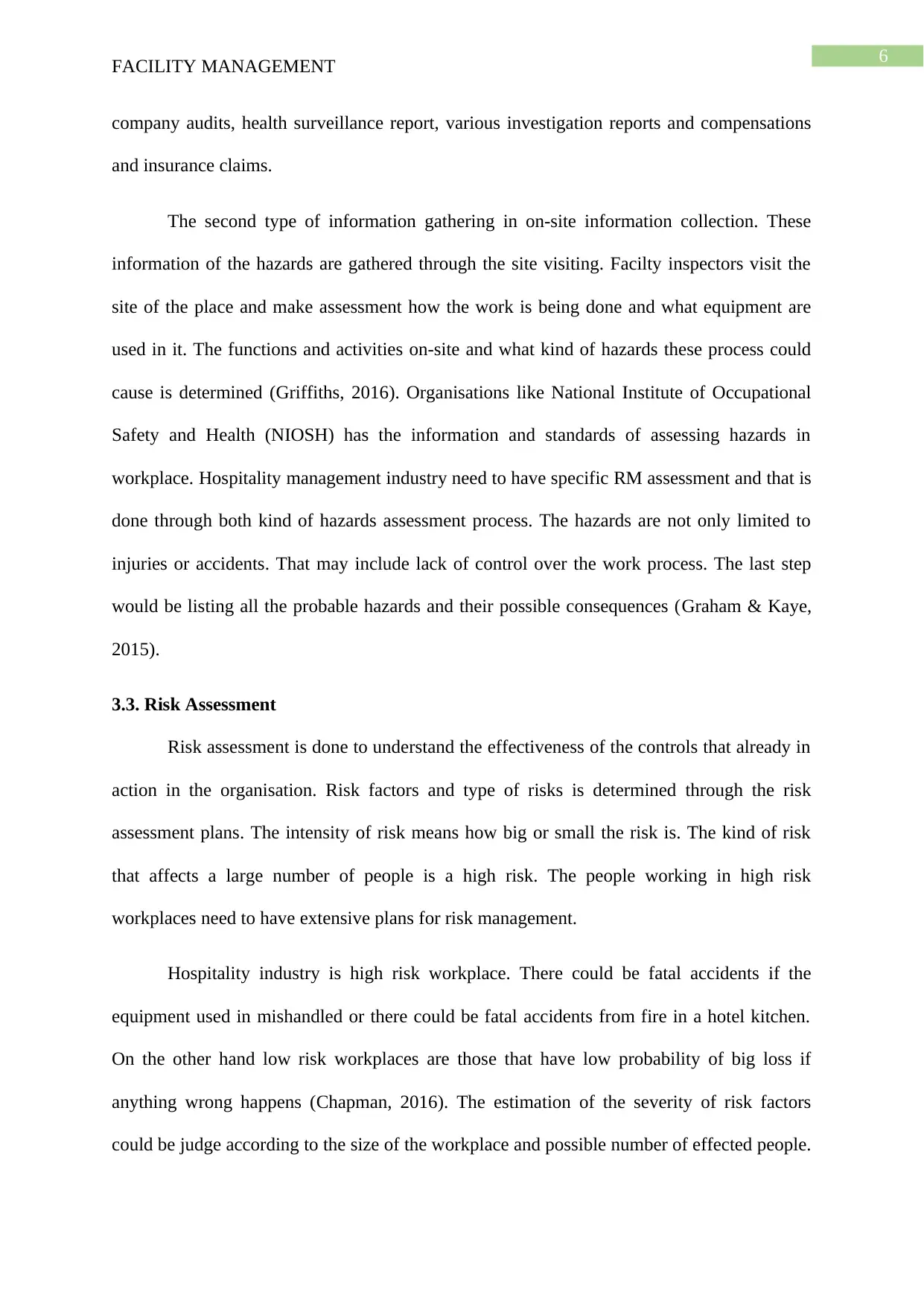
6
FACILITY MANAGEMENT
company audits, health surveillance report, various investigation reports and compensations
and insurance claims.
The second type of information gathering in on-site information collection. These
information of the hazards are gathered through the site visiting. Facilty inspectors visit the
site of the place and make assessment how the work is being done and what equipment are
used in it. The functions and activities on-site and what kind of hazards these process could
cause is determined (Griffiths, 2016). Organisations like National Institute of Occupational
Safety and Health (NIOSH) has the information and standards of assessing hazards in
workplace. Hospitality management industry need to have specific RM assessment and that is
done through both kind of hazards assessment process. The hazards are not only limited to
injuries or accidents. That may include lack of control over the work process. The last step
would be listing all the probable hazards and their possible consequences (Graham & Kaye,
2015).
3.3. Risk Assessment
Risk assessment is done to understand the effectiveness of the controls that already in
action in the organisation. Risk factors and type of risks is determined through the risk
assessment plans. The intensity of risk means how big or small the risk is. The kind of risk
that affects a large number of people is a high risk. The people working in high risk
workplaces need to have extensive plans for risk management.
Hospitality industry is high risk workplace. There could be fatal accidents if the
equipment used in mishandled or there could be fatal accidents from fire in a hotel kitchen.
On the other hand low risk workplaces are those that have low probability of big loss if
anything wrong happens (Chapman, 2016). The estimation of the severity of risk factors
could be judge according to the size of the workplace and possible number of effected people.
FACILITY MANAGEMENT
company audits, health surveillance report, various investigation reports and compensations
and insurance claims.
The second type of information gathering in on-site information collection. These
information of the hazards are gathered through the site visiting. Facilty inspectors visit the
site of the place and make assessment how the work is being done and what equipment are
used in it. The functions and activities on-site and what kind of hazards these process could
cause is determined (Griffiths, 2016). Organisations like National Institute of Occupational
Safety and Health (NIOSH) has the information and standards of assessing hazards in
workplace. Hospitality management industry need to have specific RM assessment and that is
done through both kind of hazards assessment process. The hazards are not only limited to
injuries or accidents. That may include lack of control over the work process. The last step
would be listing all the probable hazards and their possible consequences (Graham & Kaye,
2015).
3.3. Risk Assessment
Risk assessment is done to understand the effectiveness of the controls that already in
action in the organisation. Risk factors and type of risks is determined through the risk
assessment plans. The intensity of risk means how big or small the risk is. The kind of risk
that affects a large number of people is a high risk. The people working in high risk
workplaces need to have extensive plans for risk management.
Hospitality industry is high risk workplace. There could be fatal accidents if the
equipment used in mishandled or there could be fatal accidents from fire in a hotel kitchen.
On the other hand low risk workplaces are those that have low probability of big loss if
anything wrong happens (Chapman, 2016). The estimation of the severity of risk factors
could be judge according to the size of the workplace and possible number of effected people.
Paraphrase This Document
Need a fresh take? Get an instant paraphrase of this document with our AI Paraphraser

7
FACILITY MANAGEMENT
The probability and severity could be assessed on the basis of experience of the people
involved, organisational data, government agencies information and insurance company data.
The number of people that are tend to exposed in a specific hazardous situation need
to be chalked out. For example if we take the kitchen of a hotel in hospitality industry we
would understand that this is a high risk place. The risk in this workplace may include:
Mishandling of dangerous machinery and instruments
Severe injuries could happen to the people working in the kitchen by
instruments like knifes and choppers. The potential of these types of accidents
are huge. Sometimes the most trained and efficient employee may also fall
pray of these risks.
Fall on Slippery floors
The floors of the restaurant are most of the time moist with water or oil
that fall at the time of cooking (Petrovskaya et al., 2016). The chefs and other
workers in the kitchen may fall on the floor resulting into serious physical
harm. They could fall on hot implements or sharp blades. Accidents may
happen while transferring the meals to the consumer tables.
Heavy lifting and injures
Hospitality industry comprises many heavy lifting jobs. Therefore,
there is a constant possibility of strains and sprains from these heavy lifting
tasks. The people who deliver the inventory in the kitchen are the people who
suffer the most for these risks.
Chemical and burn hazards:
In restaurants and hotels, chemical substances are used in cleaning
supplies. These sanitizers and supplies present huge risk as they could affect
the person using it. Workers are exposed to open hot surfaces in the kitchen all
FACILITY MANAGEMENT
The probability and severity could be assessed on the basis of experience of the people
involved, organisational data, government agencies information and insurance company data.
The number of people that are tend to exposed in a specific hazardous situation need
to be chalked out. For example if we take the kitchen of a hotel in hospitality industry we
would understand that this is a high risk place. The risk in this workplace may include:
Mishandling of dangerous machinery and instruments
Severe injuries could happen to the people working in the kitchen by
instruments like knifes and choppers. The potential of these types of accidents
are huge. Sometimes the most trained and efficient employee may also fall
pray of these risks.
Fall on Slippery floors
The floors of the restaurant are most of the time moist with water or oil
that fall at the time of cooking (Petrovskaya et al., 2016). The chefs and other
workers in the kitchen may fall on the floor resulting into serious physical
harm. They could fall on hot implements or sharp blades. Accidents may
happen while transferring the meals to the consumer tables.
Heavy lifting and injures
Hospitality industry comprises many heavy lifting jobs. Therefore,
there is a constant possibility of strains and sprains from these heavy lifting
tasks. The people who deliver the inventory in the kitchen are the people who
suffer the most for these risks.
Chemical and burn hazards:
In restaurants and hotels, chemical substances are used in cleaning
supplies. These sanitizers and supplies present huge risk as they could affect
the person using it. Workers are exposed to open hot surfaces in the kitchen all

8
FACILITY MANAGEMENT
the time. They need to be careful while working on them, else there could be
risk of severe burning. This may affect one or more than one people. This is a
very high risk in hotel kitchens in hospitality industry (Hopkin, 2018).
Risks for crowded workplace
Hotel and restaurants are usually the crowded place. The risks of
accidents increases in the crowded place. Congested and crowded work area
might result in incidents from fall.
Hazards related to food safety
Food safety is a major issue in hotel and restaurants. Food safety, if not
maintained, could affect the customer health and the reputation of the place
(Oh, 2015).
3.4. Risk Controlling
After the assessment of risk the next step is to control the risk factors in the
workplace. The control of the risks is done through the hierarchy. In every level the risk
control need to be exercised. Risk should tried to be controlled at its source. Here are the
types of risk control in the organisational set ups-
Elimination- complete elimination of the source of risk wherever possible
Isolation- isolating the source of hazard so that the other employees do not come in
touch of the risk elements
Substitution- the risk creating instruments could be substituted with a new one that
creates less possibility of risks. Hospitality industry could use instruments that are less
harmful and easy to operate (Chapman, 2016).
Engineering control- redesigned work station and guards could reduce or control the
risk.
FACILITY MANAGEMENT
the time. They need to be careful while working on them, else there could be
risk of severe burning. This may affect one or more than one people. This is a
very high risk in hotel kitchens in hospitality industry (Hopkin, 2018).
Risks for crowded workplace
Hotel and restaurants are usually the crowded place. The risks of
accidents increases in the crowded place. Congested and crowded work area
might result in incidents from fall.
Hazards related to food safety
Food safety is a major issue in hotel and restaurants. Food safety, if not
maintained, could affect the customer health and the reputation of the place
(Oh, 2015).
3.4. Risk Controlling
After the assessment of risk the next step is to control the risk factors in the
workplace. The control of the risks is done through the hierarchy. In every level the risk
control need to be exercised. Risk should tried to be controlled at its source. Here are the
types of risk control in the organisational set ups-
Elimination- complete elimination of the source of risk wherever possible
Isolation- isolating the source of hazard so that the other employees do not come in
touch of the risk elements
Substitution- the risk creating instruments could be substituted with a new one that
creates less possibility of risks. Hospitality industry could use instruments that are less
harmful and easy to operate (Chapman, 2016).
Engineering control- redesigned work station and guards could reduce or control the
risk.
⊘ This is a preview!⊘
Do you want full access?
Subscribe today to unlock all pages.

Trusted by 1+ million students worldwide
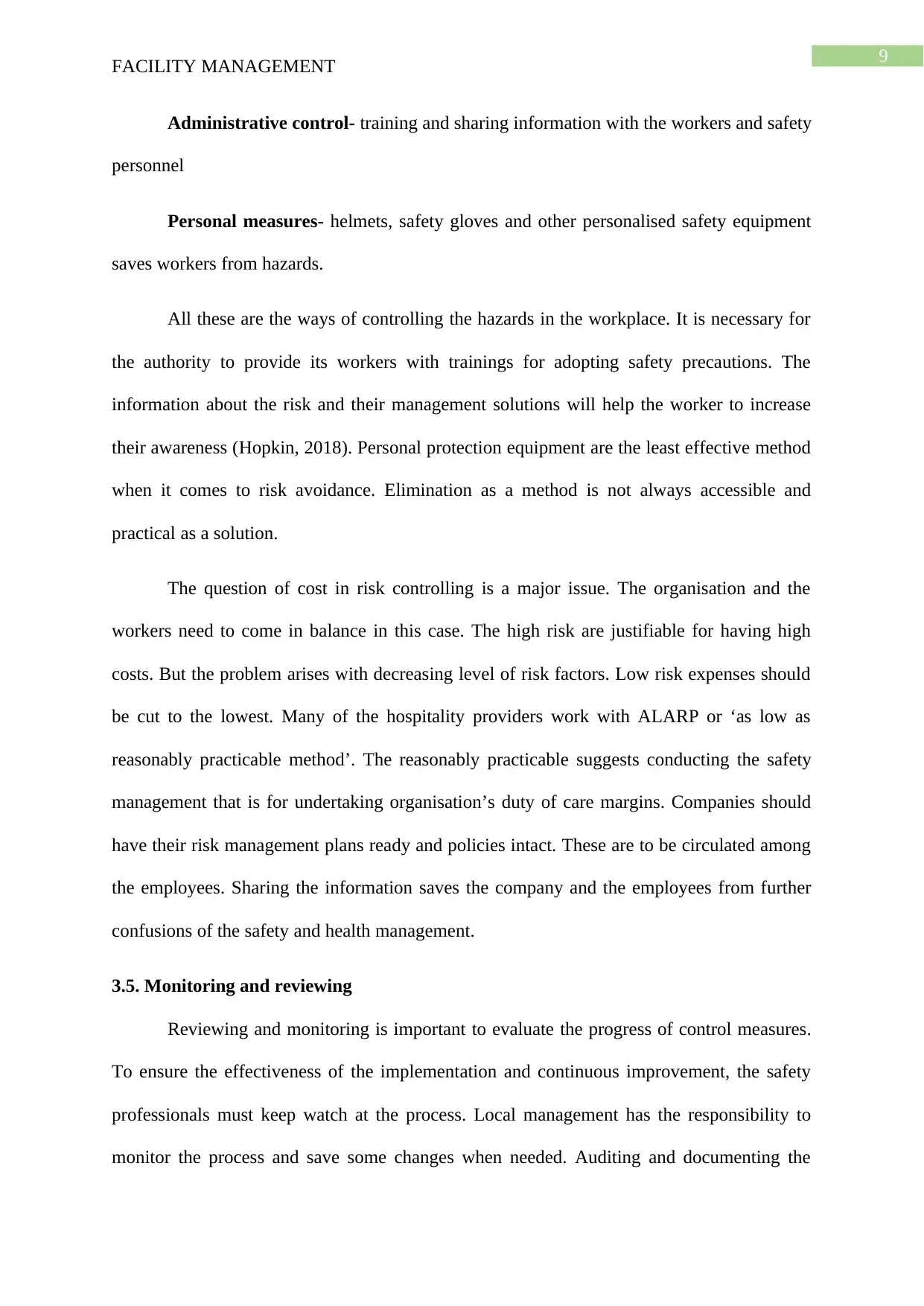
9
FACILITY MANAGEMENT
Administrative control- training and sharing information with the workers and safety
personnel
Personal measures- helmets, safety gloves and other personalised safety equipment
saves workers from hazards.
All these are the ways of controlling the hazards in the workplace. It is necessary for
the authority to provide its workers with trainings for adopting safety precautions. The
information about the risk and their management solutions will help the worker to increase
their awareness (Hopkin, 2018). Personal protection equipment are the least effective method
when it comes to risk avoidance. Elimination as a method is not always accessible and
practical as a solution.
The question of cost in risk controlling is a major issue. The organisation and the
workers need to come in balance in this case. The high risk are justifiable for having high
costs. But the problem arises with decreasing level of risk factors. Low risk expenses should
be cut to the lowest. Many of the hospitality providers work with ALARP or ‘as low as
reasonably practicable method’. The reasonably practicable suggests conducting the safety
management that is for undertaking organisation’s duty of care margins. Companies should
have their risk management plans ready and policies intact. These are to be circulated among
the employees. Sharing the information saves the company and the employees from further
confusions of the safety and health management.
3.5. Monitoring and reviewing
Reviewing and monitoring is important to evaluate the progress of control measures.
To ensure the effectiveness of the implementation and continuous improvement, the safety
professionals must keep watch at the process. Local management has the responsibility to
monitor the process and save some changes when needed. Auditing and documenting the
FACILITY MANAGEMENT
Administrative control- training and sharing information with the workers and safety
personnel
Personal measures- helmets, safety gloves and other personalised safety equipment
saves workers from hazards.
All these are the ways of controlling the hazards in the workplace. It is necessary for
the authority to provide its workers with trainings for adopting safety precautions. The
information about the risk and their management solutions will help the worker to increase
their awareness (Hopkin, 2018). Personal protection equipment are the least effective method
when it comes to risk avoidance. Elimination as a method is not always accessible and
practical as a solution.
The question of cost in risk controlling is a major issue. The organisation and the
workers need to come in balance in this case. The high risk are justifiable for having high
costs. But the problem arises with decreasing level of risk factors. Low risk expenses should
be cut to the lowest. Many of the hospitality providers work with ALARP or ‘as low as
reasonably practicable method’. The reasonably practicable suggests conducting the safety
management that is for undertaking organisation’s duty of care margins. Companies should
have their risk management plans ready and policies intact. These are to be circulated among
the employees. Sharing the information saves the company and the employees from further
confusions of the safety and health management.
3.5. Monitoring and reviewing
Reviewing and monitoring is important to evaluate the progress of control measures.
To ensure the effectiveness of the implementation and continuous improvement, the safety
professionals must keep watch at the process. Local management has the responsibility to
monitor the process and save some changes when needed. Auditing and documenting the
Paraphrase This Document
Need a fresh take? Get an instant paraphrase of this document with our AI Paraphraser
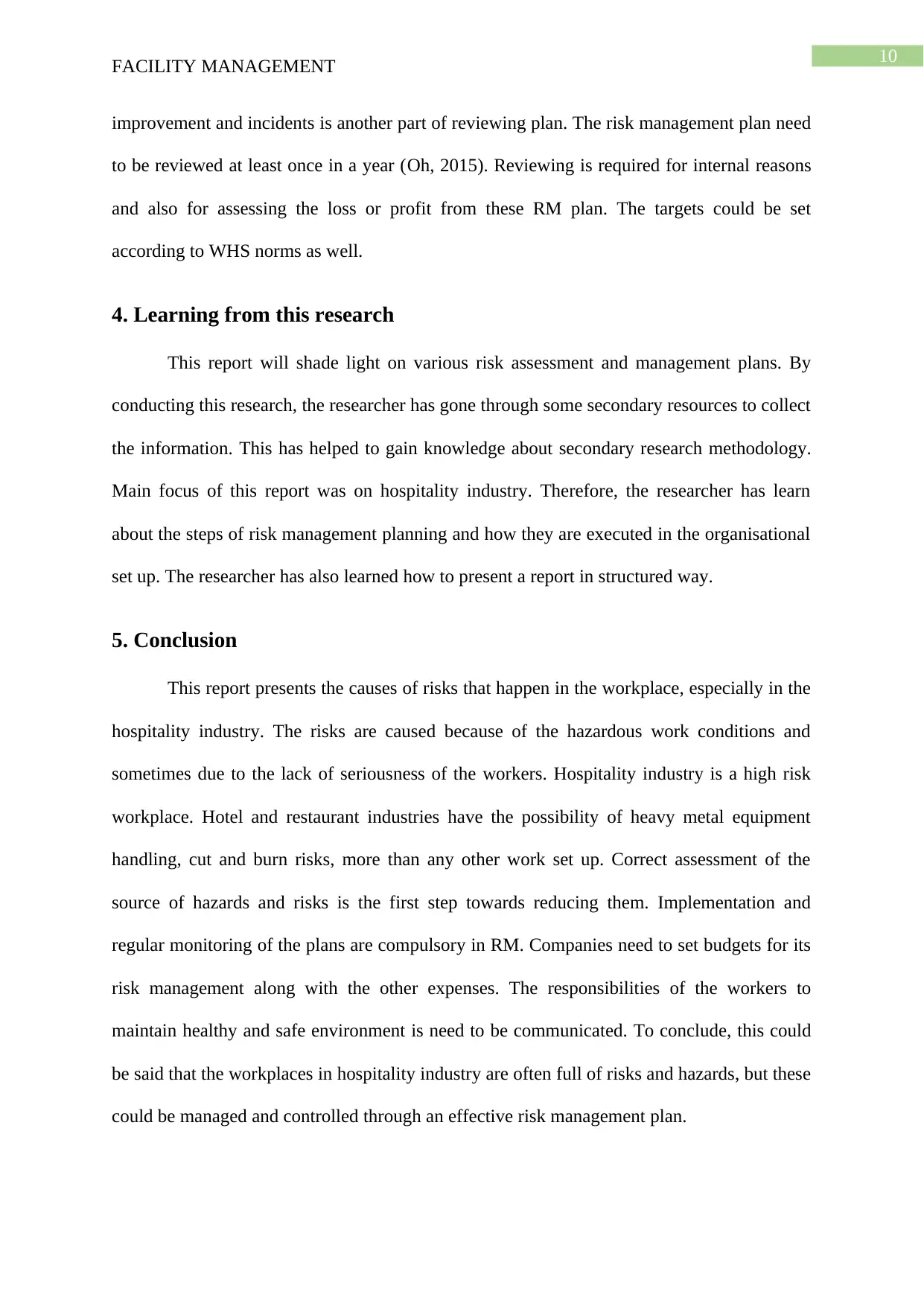
10
FACILITY MANAGEMENT
improvement and incidents is another part of reviewing plan. The risk management plan need
to be reviewed at least once in a year (Oh, 2015). Reviewing is required for internal reasons
and also for assessing the loss or profit from these RM plan. The targets could be set
according to WHS norms as well.
4. Learning from this research
This report will shade light on various risk assessment and management plans. By
conducting this research, the researcher has gone through some secondary resources to collect
the information. This has helped to gain knowledge about secondary research methodology.
Main focus of this report was on hospitality industry. Therefore, the researcher has learn
about the steps of risk management planning and how they are executed in the organisational
set up. The researcher has also learned how to present a report in structured way.
5. Conclusion
This report presents the causes of risks that happen in the workplace, especially in the
hospitality industry. The risks are caused because of the hazardous work conditions and
sometimes due to the lack of seriousness of the workers. Hospitality industry is a high risk
workplace. Hotel and restaurant industries have the possibility of heavy metal equipment
handling, cut and burn risks, more than any other work set up. Correct assessment of the
source of hazards and risks is the first step towards reducing them. Implementation and
regular monitoring of the plans are compulsory in RM. Companies need to set budgets for its
risk management along with the other expenses. The responsibilities of the workers to
maintain healthy and safe environment is need to be communicated. To conclude, this could
be said that the workplaces in hospitality industry are often full of risks and hazards, but these
could be managed and controlled through an effective risk management plan.
FACILITY MANAGEMENT
improvement and incidents is another part of reviewing plan. The risk management plan need
to be reviewed at least once in a year (Oh, 2015). Reviewing is required for internal reasons
and also for assessing the loss or profit from these RM plan. The targets could be set
according to WHS norms as well.
4. Learning from this research
This report will shade light on various risk assessment and management plans. By
conducting this research, the researcher has gone through some secondary resources to collect
the information. This has helped to gain knowledge about secondary research methodology.
Main focus of this report was on hospitality industry. Therefore, the researcher has learn
about the steps of risk management planning and how they are executed in the organisational
set up. The researcher has also learned how to present a report in structured way.
5. Conclusion
This report presents the causes of risks that happen in the workplace, especially in the
hospitality industry. The risks are caused because of the hazardous work conditions and
sometimes due to the lack of seriousness of the workers. Hospitality industry is a high risk
workplace. Hotel and restaurant industries have the possibility of heavy metal equipment
handling, cut and burn risks, more than any other work set up. Correct assessment of the
source of hazards and risks is the first step towards reducing them. Implementation and
regular monitoring of the plans are compulsory in RM. Companies need to set budgets for its
risk management along with the other expenses. The responsibilities of the workers to
maintain healthy and safe environment is need to be communicated. To conclude, this could
be said that the workplaces in hospitality industry are often full of risks and hazards, but these
could be managed and controlled through an effective risk management plan.

11
FACILITY MANAGEMENT
6. References
Apostolou, A. (2019). Case study of the risk management plan ensuring business
continuity of a private healthcare organisation, after a manager change.
Chapman, R. J. (2016). The rules of project risk management: Implementation
guidelines for major projects. Routledge.
Graham, J., & Kaye, D. (2015). A Risk Management Approach to Business
Continuity: Aligning Business Continuity and Corporate Governance.
Rothstein Publishing.
Griffiths, P. (2016). Risk-based auditing. Routledge.
Hopkin, P. (2018). Fundamentals of risk management: understanding, evaluating and
implementing effective risk management. Kogan Page Publishers.
Oh, S. T. (2015). Study on the accident of kitchen food service industry employees in
accordance with the safety and environment awareness and accident
experience. Culinary science and hospitality research, 21(2), 85-102.
Petrovskaya, M. V., Zaitseva, N. A., Bondarchuk, N. V., Grigorieva, E. M., &
Vasilieva, L. S. (2016). Scientific methodological basis of the risk
management implementation for companies’ capital structure optimization.
International Electronic Journal of Mathematics Education, 11(7), 2571-2580.
Sadgrove, K. (2016). The complete guide to business risk management. Routledge.
FACILITY MANAGEMENT
6. References
Apostolou, A. (2019). Case study of the risk management plan ensuring business
continuity of a private healthcare organisation, after a manager change.
Chapman, R. J. (2016). The rules of project risk management: Implementation
guidelines for major projects. Routledge.
Graham, J., & Kaye, D. (2015). A Risk Management Approach to Business
Continuity: Aligning Business Continuity and Corporate Governance.
Rothstein Publishing.
Griffiths, P. (2016). Risk-based auditing. Routledge.
Hopkin, P. (2018). Fundamentals of risk management: understanding, evaluating and
implementing effective risk management. Kogan Page Publishers.
Oh, S. T. (2015). Study on the accident of kitchen food service industry employees in
accordance with the safety and environment awareness and accident
experience. Culinary science and hospitality research, 21(2), 85-102.
Petrovskaya, M. V., Zaitseva, N. A., Bondarchuk, N. V., Grigorieva, E. M., &
Vasilieva, L. S. (2016). Scientific methodological basis of the risk
management implementation for companies’ capital structure optimization.
International Electronic Journal of Mathematics Education, 11(7), 2571-2580.
Sadgrove, K. (2016). The complete guide to business risk management. Routledge.
⊘ This is a preview!⊘
Do you want full access?
Subscribe today to unlock all pages.

Trusted by 1+ million students worldwide
1 out of 12
Related Documents
Your All-in-One AI-Powered Toolkit for Academic Success.
+13062052269
info@desklib.com
Available 24*7 on WhatsApp / Email
![[object Object]](/_next/static/media/star-bottom.7253800d.svg)
Unlock your academic potential
Copyright © 2020–2026 A2Z Services. All Rights Reserved. Developed and managed by ZUCOL.




